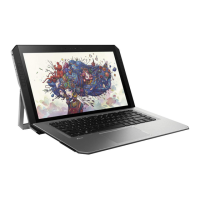12. Test with veried working conguration (hardware and/or operating system)
One troubleshooting technique that can quickly isolate an issue is using a veried working part while testing. A
good example is to use an external keyboard, mouse, or VGA monitor when you have issues with an internal
keyboard, TouchPad, or display. Testing with a veried working AC adapter can identify an error caused by a
faulty one. Similarly, testing with a veried working operating system can determine bad behaviors of the
current operating system. See Non HP diagnostics tools on page 67 for instructions about obtaining and using a
Windows-To-Go USB.
NOTE: In some situations, more than one item may contribute to a problem.
13. Replace the system board
The system board may be replaced only by authorized service providers. This should not be considered an initial
step taken to resolve an issue. Review and perform all steps discussed previously before replacing the system
board. 4. Update BIOS and drivers on page 63, 7. Status lights, blinking light codes, troubleshooting lights, and
POST error messages on page 68, 8. Hard reset on page 70, and 9. Soft reset (Default Settings) on page 71,
and/or 10. Reseat cables and connections on page 72 can resolve many system board issues without requiring
the eort of replacing unnecessary hardware.
Review Table 6-1 Troubleshooting methodology and general troubleshooting steps on page 59 for appropriate
troubleshooting steps.
IMPORTANT: System board failure is not common. Do not replace the system board until you have tried all
other troubleshooting options.
NOTE: Determine whether a previous service case might be related to the current problem. For example, a fan
detection issue may be caused by a loose connection resulting from previous service.
TIP: Without an RTC battery (3V coin-cell battery), the computer automatically reboots. This is a useful feature
when the power connector cable (between external AC adapter and system board) is defective.
NOTE: Most of the time, eective troubleshooting can prevent a system board replacement.
Items that may prevent resolution of the issue:
● The information provided about the issue omits key details, including any actions taken before the issue
occurred.
● BIOS, software, and drivers have not been updated.
● Cables or connections are loose.
● Technician is unaware of information available from the HP Support website (i.e., CA - Customer Advisory).
● The issue is related to existing or known issues that may be identied in existing support articles.
● Technician may have omitted steps in the provided repair instructions (e.g., Spare Part Replacement
Instructions).
● Skipping one of steps from Troubleshooting Methodology table results in No Defect Found (NDF)/No Fault
Found (NFF)/No Issue Detected (NID) messages.
74 Chapter 6 Troubleshooting guide

